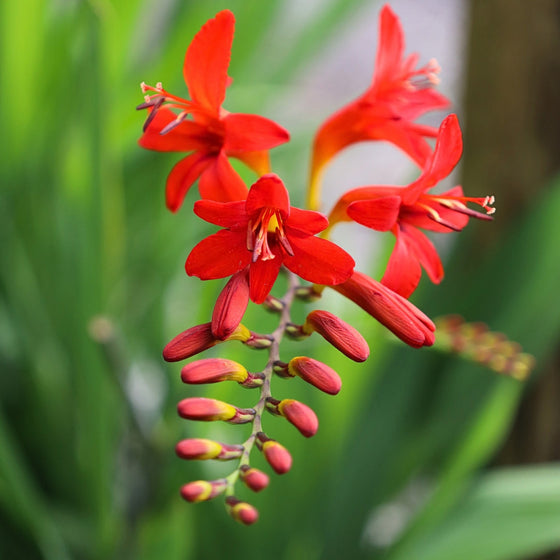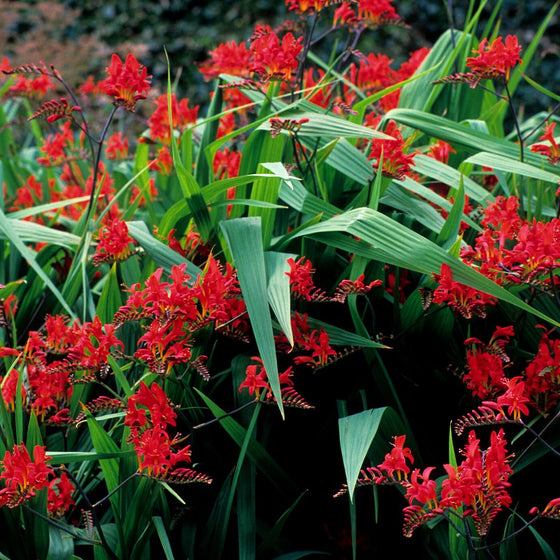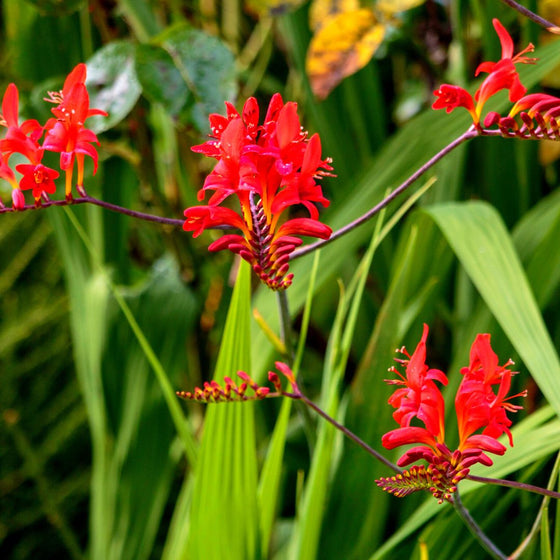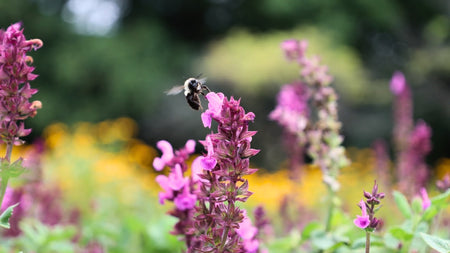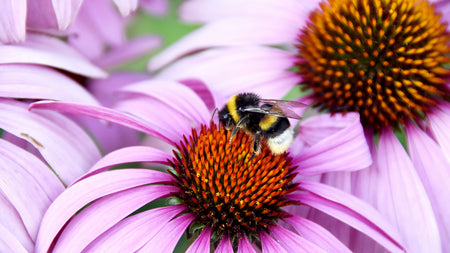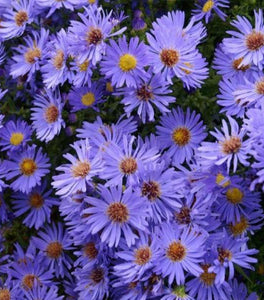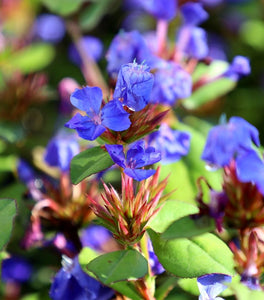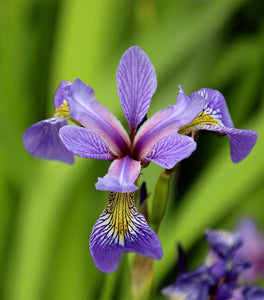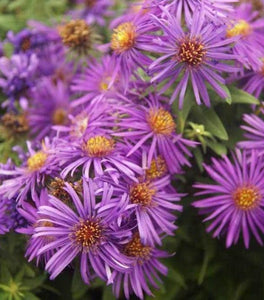
Images Depict Mature Plants
Crocosmia Lucifer
Crocosmia ‘Lucifer’ is a bold, eye-catching perennial that brings fiery drama to the summer garden. Known for its vibrant scarlet-red, tubular flowers, this variety is a magnet for hummingbirds, butterflies, and other pollinators. Blooming in mid to late summer, the upright flower spikes rise above graceful, sword-like green foliage, adding dynamic height and color to sunny borders, cutting gardens, and mixed perennial beds. With its exotic look and vibrant bloom color, Crocosmia ‘Lucifer’ adds a tropical flair that commands attention.
This hardy perennial thrives in full sun to part shade and prefers moist, well-drained soil, though it will tolerate short periods of drought once established. Reaching 3 to 4 feet tall, it makes a stunning backdrop when planted in masses or alongside ornamental grasses and summer bloomers like coneflowers and black-eyed Susans. Crocosmia ‘Lucifer’ is also an excellent choice for containers and cottage gardens, where its upright habit and fiery blooms can be enjoyed up close.
Not only is Crocosmia ‘Lucifer’ deer and rabbit resistant, but it also makes an excellent cut flower and lasts well in floral arrangements. Its clump-forming habit allows it to naturalize gracefully over time without becoming invasive. For a low-maintenance perennial with high visual impact, Crocosmia ‘Lucifer’ delivers unmatched beauty and performance in the summer landscape.

| Hardiness Zone: | 5-9 |
|---|---|
| Mature Height: | 2 to 3 feet |
| Mature Width: | 2 to 3 feet |
| Classification: | Flowering Perennial |
| Sunlight: | Full Sun to light shade |
| Habit: | Upright, clump forming |
| Flower Color: | Fiery Red |
| Flowering Season: | Late Summer To Early Fall |
| Foliage: | Vibrant Green Sword-Shaped |
| Soil Condition: | Prefers dry, average to slightly moist soil, wont tolerate wet soil in winter |
| Water Requirements: | Water well until established. |
| Uses: | Extremely attractive when used as a focal point in the mixed border, mass planting. Attracts pollinators. |
How to Care for Crocosmia Lucifer
Before you buy a Crocosmia ‘Lucifer’, make sure to read about the care instructions that are recommended to keep this plant healthy and thriving.
How Should I Plant a Potted Crocosmia Lucifer Plant?
To plant a potted Crocosmia ‘Lucifer’ plant, begin by selecting a sunny location with well-drained, fertile soil—this perennial performs best in full sun but can tolerate light afternoon shade. Dig a hole twice as wide and the same depth as the nursery pot to ensure the roots can spread easily. Carefully remove the Crocosmia from its container, gently loosening any bound roots, and place it into the hole so that the top of the root ball is level with the surrounding soil. Backfill with amended soil, press gently to remove air pockets, and water thoroughly to help settle the roots and eliminate transplant shock. After planting your Crocosmia ‘Lucifer’, space additional plants 8 to 12 inches apart to allow for air circulation and room to naturalize. Apply a layer of mulch around the base (keeping it away from the crown) to retain moisture and suppress weeds, especially during the first growing season. This variety of Crocosmia is known for its clump-forming habit and tall, arching flower spikes that add height and vibrant red color to pollinator gardens, borders, and mixed beds. With proper planting and care, your potted Crocosmia ‘Lucifer’ will adapt quickly and produce brilliant blooms throughout the summer.
How Should I Water a Crocosmia Lucifer Plant?
Watering your Crocosmia ‘Lucifer’ properly is essential for establishing strong roots and encouraging vibrant summer blooms. After planting, water deeply to help the plant settle into the soil and continue to water regularly during the first growing season, keeping the soil consistently moist but never soggy. Once established, Crocosmia is relatively drought-tolerant, but consistent watering during extended dry periods will help maintain lush foliage and prolong blooming. Always water at the base of the plant to prevent fungal issues on the leaves and flower spikes. In containers, Crocosmia ‘Lucifer’ may require more frequent watering, especially during hot weather, as potted soil dries out faster than garden beds. Check the top inch of soil regularly and water when it begins to feel dry. Avoid allowing the plant to sit in standing water, which can cause root rot. A layer of mulch around the base of in-ground plants will help retain soil moisture and reduce the need for frequent watering. With the right watering routine, your Crocosmia ‘Lucifer’ will deliver tall, fiery-red blooms and healthy growth season after season.
How Should I Fertilize Crocosmia Lucifer Plants?
To fertilize Crocosmia ‘Lucifer’ effectively, apply a balanced, slow-release fertilizer—such as a 10-10-10 or 5-10-5—in early spring as new shoots emerge. This provides essential nutrients to support strong root development and vigorous flower production. Work the fertilizer gently into the soil around the plant's base, avoiding direct contact with the crown, and water thoroughly to help nutrients reach the root zone. This initial feeding encourages the bold, upright growth and brilliant red blooms that Crocosmia ‘Lucifer’ is known for during the summer months. If your soil is lean or you want to boost flowering, you can supplement with a water-soluble fertilizer every 4–6 weeks during the growing season. However, avoid over-fertilizing, particularly with high-nitrogen formulas, as this can lead to excessive leafy growth at the expense of flowers. For plants grown in containers, more frequent feeding with diluted liquid fertilizer may be necessary due to nutrient leaching. With a proper fertilization plan, Crocosmia ‘Lucifer’ will reward you with healthy foliage and a vibrant display of scarlet blooms perfect for cut flower gardens and pollinator-friendly landscapes.

How and When Should I Prune a Crocosmia Lucifer Plant?
Crocosmia ‘Lucifer’ requires minimal pruning, but timely maintenance will enhance its performance and appearance. The best time to prune is in late fall or early spring. After the flowering season ends in late summer, allow the foliage to remain in place through fall, as it continues to photosynthesize and store energy in the corms for next year’s blooms. Once the foliage turns yellow or brown and dies back naturally—typically by late autumn—you can trim it down to the ground using clean garden shears. Removing spent leaves and flower stalks not only tidies up the garden but also helps prevent pests and disease. During the growing season, deadheading spent flower spikes can improve the overall appearance of the plant, although it’s not essential for continued blooming. In early spring, before new shoots appear, clear away any remaining debris and inspect for signs of overcrowding. If the clumps have grown dense over several seasons, this is also a good time to lift and divide the corms to rejuvenate the plant and promote better air circulation. With proper seasonal pruning, your Crocosmia ‘Lucifer’ will return year after year with a show-stopping display of bold, red blooms and healthy, arching foliage.

